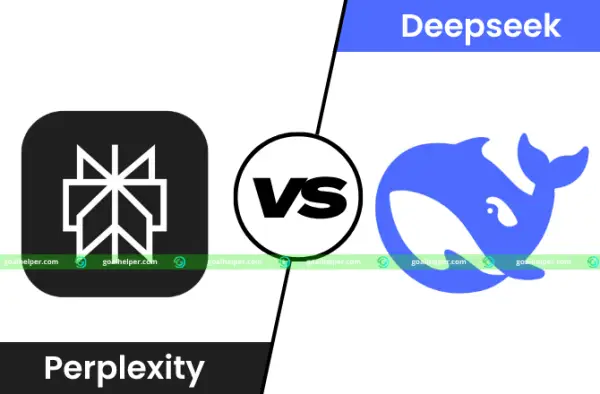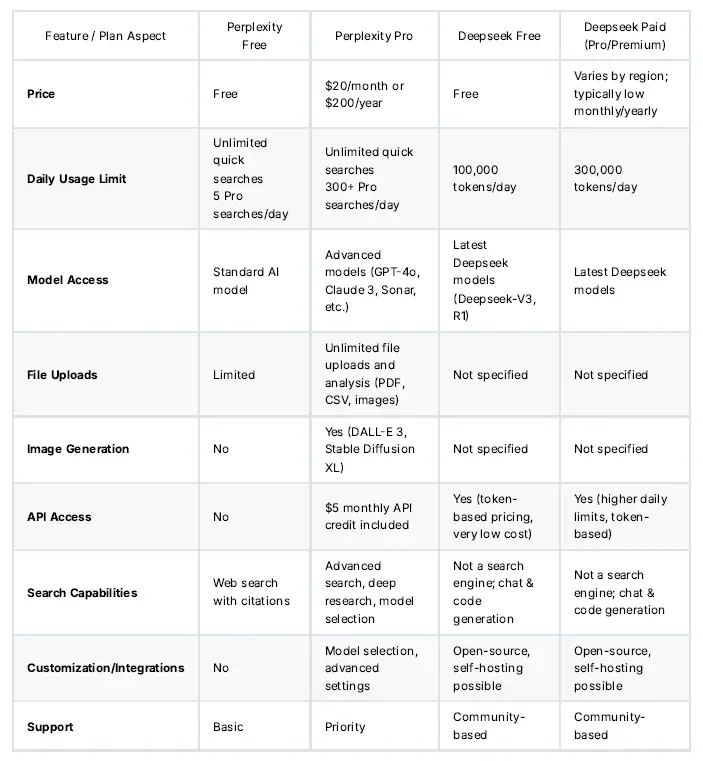Compare AI Writing Assistant: Perplexity vs Deepseek Features

Dive into our Perplexity vs. DeepSeek comparison to discover the best AI writing tool that elevates your content strategy with real-time accuracy and innovative efficiency. Explore Perplexity features vs Deepseek features by leveraging Perplexity’s citation-backed, up-to-date answers and Deepseek’s cost-efficient, high-performance mixture-of-experts architecture to power your next SEO-optimized campaign.
1. AI Model & Output Quality
Why it matters: High-quality AI output minimizes editing time and ensures clarity, coherence, and factual accuracy.
- Perplexity: Utilizes top-tier language models like GPT-4, Claude 3, and Mistral, with real-time web grounding to provide accurate, sourced answers.
- DeepSeek: Uses proprietary models such as DeepSeek-V3, R1, and Janus Pro with Mixture-of-Experts architecture, delivering solid reasoning and multilingual performance, though slightly behind Perplexity in English fluency.
- Better: Perplexity – its use of multiple high-end models and web grounding leads to more reliable and comprehensive results.
2. Content Specialization & SEO Capabilities
Why it matters: SEO-focused tools help content rank better on search engines and attract organic traffic.
- Perplexity: Primarily designed for research and factual query resolution, with limited SEO-specific features.
- DeepSeek: Built with SEO in mind, offering specialized prompts for keyword optimization, meta descriptions, and content analysis.
- Better: DeepSeek – its built-in SEO tools and structured prompts give it a clear advantage in content optimization.
3. Style Control & Customization
Why it matters: Tailoring tone, voice, and output format is crucial for brand alignment and audience engagement.
- Perplexity: Offers general style adjustments via prompt engineering and conversation modes but lacks advanced formatting or reusable style templates.
- DeepSeek: Allows model selection and detailed stylistic prompts, with multimodal output options and flexible formatting capabilities.
- Better: DeepSeek – greater control over tone and formatting allows more precise content tailoring.
4. Integration & Workflow Compatibility
Why it matters: Seamless integration with existing tools boosts productivity and reduces manual effort.
- Perplexity: Supports browser extensions, APIs, and enterprise-level integrations, making it easy to embed into various workflows.
- DeepSeek: Offers API access and browser extension support but has fewer built-in integrations for publishing platforms or enterprise tools.
- Better: Perplexity – its mature API ecosystem and integration options support more versatile use cases.
5. Collaboration & Team Features
Why it matters: Effective team collaboration enables shared editing, version control, and content consistency.
- Perplexity: Includes collaborative features such as shared workspaces, document upload, access control, and team-based content organization.
- DeepSeek: Primarily focused on individual use; lacks native collaboration tools or shared environments.
- Better: Perplexity – team-ready features make it the better choice for organizations and group workflows.
6. User Interface & Usability
Why it matters: A clean, intuitive interface helps users adopt tools quickly and reduces learning time.
- Perplexity: Offers a streamlined interface with clear chat history, citation display, and guided modes, highly praised for simplicity.
- DeepSeek: Features a modern UI with advanced options, including multimodal panels and prompt libraries, though it may have a steeper learning curve.
- Better: Perplexity – its focused design and ease of use improve user onboarding and day-to-day experience.
7. Content Analytics & Optimization
Why it matters: Analytics reveal what’s working and guide improvements in content strategy.
- Perplexity: Provides basic usage metrics and analytics for content partners but lacks built-in SEO or A/B testing dashboards.
- DeepSeek: Includes SEO-driven analytics like keyword trends, gap analysis, and content scoring within its prompt interface.
- Better: DeepSeek – deeper optimization and SEO analytics give users more actionable insights.
8. Support & Security
Why it matters: Enterprise adoption depends on data protection, support availability, and regulatory compliance.
- Perplexity: Offers enterprise-level security (SOC-2 compliance, encryption), structured support, and transparent data policies.
- DeepSeek: As an open-source tool, support is community-based; hosting and security vary based on implementation, which may raise compliance concerns.
- Better: Perplexity – its enterprise-grade security and structured support give it the edge for business use.
9. Pricing & Value for Money
Why it matters: Cost efficiency ensures scalability and sustained use over time.
- Perplexity: Offers a free tier and subscription plans with access to premium models, collaborative tools, and API credits.
DeepSeek: Entirely free and open-source for core model usage, with optional hosting or API costs depending on the deployment setup.

- Perplexity:
- Free plan is great for unlimited basic searches and light use of advanced models.
- Pro unlocks hundreds of daily advanced searches, top-tier models (GPT-4o, Claude 3), unlimited file uploads, image generation, API credit, and priority support.
- Deepseek:
- Free plan offers generous daily token limits for chat and code generation with the latest models.
- Paid plans increase daily token limits and may offer faster performance; all features and models are included in both plans.
- Deepseek is open-source, supports self-hosting, and is extremely cost-effective for developers and power users.
🔹 Perplexity – Read More »
🔸 Deepseek – Read More »
Summary of Perplexity and Deepseek Comparison
| Criterion | Perplexity Rating | Deepseek Rating | Notes |
| AI Model & Output Quality | ★★★★★ | ★★★★☆ | Perplexity uses multiple top-tier LLMs with real-time grounding, while Deepseek’s Mixture-of-Experts offers strong reasoning but slightly lower fluency. |
| Content Specialization & SEO | ★★☆☆☆ | ★★★★☆ | Deepseek includes built-in SEO prompts; Perplexity focuses on research over optimization. |
| Style Control & Customization | ★★★☆☆ | ★★★★☆ | Deepseek enables detailed style prompts and multimodal outputs; Perplexity relies on manual prompt tweaks. |
| Integration & Workflow Compatibility | ★★★★★ | ★★☆☆☆ | Perplexity offers mature APIs and enterprise connectors; Deepseek has basic API and extension support. |
| Collaboration & Team Features | ★★★★★ | ★☆☆☆☆ | Perplexity’s shared workspaces and access controls outshine Deepseek’s individual-centric design. |
| User Interface & Usability | ★★★★★ | ★★★☆☆ | Perplexity’s clean chat/search UI is more intuitive than Deepseek’s feature-dense interface. |
| Content Analytics & Optimization | ★★☆☆☆ | ★★★★☆ | Deepseek embeds keyword trends and gap analysis; Perplexity provides only basic usage metrics. |
| Support & Security | ★★★★★ | ★★☆☆☆ | Enterprise-grade SLAs and compliance give Perplexity a security edge over community-supported Deepseek. |
| Pricing & Value for Money | ★★★☆☆ | ★★★★★ | Deepseek’s open-source core models cost only hosting; Perplexity’s SaaS plans may be pricier for large teams. |
Perplexity or Deepseek: Top FAQs for AI Writing Assistants
What is the main difference between Perplexity and Deepseek?
Perplexity is a research-focused AI engine offering real-time web grounding and citations, while Deepseek is an open-source LLM platform built for end-to-end content generation and SEO optimization.
How do Perplexity pricing plans compare to Deepseek pricing?
Perplexity provides a free tier plus paid Pro and Enterprise subscriptions with API credits and collaboration tools, whereas Deepseek’s core models are free to self-host and only incur costs if you use managed API services.
Which tool offers better SEO capabilities?
Perplexity excels at fast, accurate fact retrieval but lacks specialized SEO workflows; Deepseek includes built-in keyword research prompts, meta-description generators, and content-gap analysis.
What AI models power Perplexity and Deepseek, and how does output quality compare?
Perplexity leverages top models like GPT-4, Claude 3, and Mistral with web grounding to reduce errors, while DeepSeek’s R1 and Janus Pro models use a Mixture-of-Experts architecture that delivers robust reasoning and multimodal outputs.
Does Perplexity provide source citations in its answers?
Yes. Perplexity automatically attaches inline citations to sourced information for enhanced transparency.
Is Deepseek open-source and free to self-host?
Yes. Deepseek’s main LLMs are open-source and free for self-hosting; you only pay if you choose a managed API or cloud hosting option.
Which tool is better for team collaboration features?
Perplexity includes shared workspaces, document uploads, and access controls for seamless teamwork, while Deepseek lacks built-in collaboration environments.
What integration options do Perplexity and Deepseek support?
Perplexity offers a robust public API, browser extensions, and enterprise connectors; Deepseek provides API access and a browser extension but has fewer native platform integrations.
How does Deepseek’s performance compare to GPT-4?
Deepseek’s R1 model often matches or exceeds standard benchmarks for reasoning and coding challenges, though GPT-4 remains slightly stronger in nuanced English fluency.
Can Deepseek handle multimodal content or long-form context?
Yes. Deepseek-R1 supports very large context windows, and Janus Pro adds multimodal outputs (text plus images) for richer content creation.
Which tool is more user-friendly for beginners?
Perplexity’s clean, chat-style interface with guided modes makes it easy for new users, while Deepseek’s advanced features may require a steeper learning curve.
What support and security features does Perplexity offer?
Perplexity delivers enterprise-grade SLAs, compliance certifications, end-to-end encryption, and transparent data policies.
